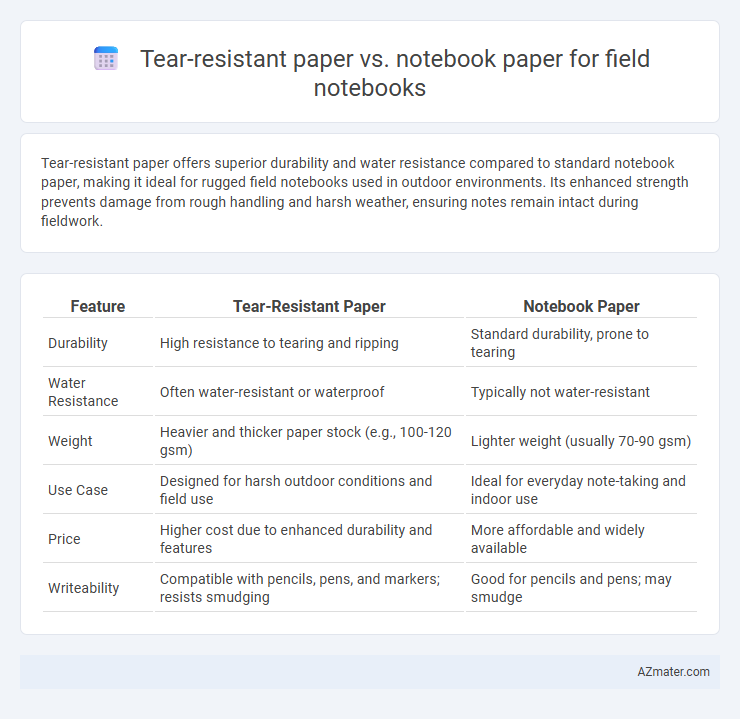Tear-resistant paper offers superior durability and water resistance compared to standard notebook paper, making it ideal for rugged field notebooks used in outdoor environments. Its enhanced strength prevents damage from rough handling and harsh weather, ensuring notes remain intact during fieldwork.
Table of Comparison
| Feature | Tear-Resistant Paper | Notebook Paper |
|---|---|---|
| Durability | High resistance to tearing and ripping | Standard durability, prone to tearing |
| Water Resistance | Often water-resistant or waterproof | Typically not water-resistant |
| Weight | Heavier and thicker paper stock (e.g., 100-120 gsm) | Lighter weight (usually 70-90 gsm) |
| Use Case | Designed for harsh outdoor conditions and field use | Ideal for everyday note-taking and indoor use |
| Price | Higher cost due to enhanced durability and features | More affordable and widely available |
| Writeability | Compatible with pencils, pens, and markers; resists smudging | Good for pencils and pens; may smudge |
Introduction to Field Notebooks: Choosing the Right Paper
Field notebooks require durable tear-resistant paper that withstands rough outdoor conditions and frequent handling, ensuring notes remain intact during fieldwork. Unlike standard notebook paper, tear-resistant paper offers enhanced strength and water resistance, crucial for researchers, geologists, and environmentalists who work in challenging environments. Selecting the right paper enhances the longevity and usability of field notebooks, making tear-resistant materials the optimal choice for reliability and durability.
What Is Tear-Resistant Paper?
Tear-resistant paper is specially engineered to withstand rough handling, moisture, and frequent use without ripping, making it ideal for field notebooks used in challenging environments. Unlike standard notebook paper, tear-resistant paper often incorporates synthetic fibers or coatings that enhance durability and water resistance. This type of paper ensures that notes remain intact and legible during outdoor activities, construction sites, or scientific research in the field.
Standard Notebook Paper: Features and Limitations
Standard notebook paper typically consists of 70-90 GSM wood pulp, offering smooth writing surfaces but limited durability in harsh field conditions. It absorbs moisture easily, resulting in potential tearing and ink smudging, which makes it less suitable for outdoor, rugged environments. Unlike tear-resistant paper designed with synthetic fibers or waterproof coatings, standard notebook paper lacks resilience against water, dirt, and rough handling, reducing its reliability for sustained fieldwork.
Durability in the Field: Tear-Resistant vs Regular Paper
Tear-resistant paper offers exceptional durability for field notebooks, with enhanced resistance to ripping and wear even in harsh outdoor conditions, making it ideal for rugged environments. Regular notebook paper lacks the reinforced fibers and coating that provide tear resistance, leading to potential damage from moisture, rough handling, and frequent use. Field professionals benefit from tear-resistant paper as it ensures notes remain intact and legible despite exposure to dirt, water, and abrasion.
Water and Weather Resistance Comparison
Tear-resistant paper outperforms standard notebook paper in field notebooks by offering superior water and weather resistance, ensuring durability during adverse conditions such as rain, snow, or humidity. This specialized paper uses synthetic fibers or coatings to repel water, preventing ink smudging and maintaining legibility. Unlike traditional cellulose-based notebook paper, tear-resistant variants retain strength and integrity when exposed to moisture, making them ideal for outdoor use and harsh environments.
Writing Experience: Pen and Pencil Compatibility
Tear-resistant paper in field notebooks offers superior durability that enhances writing stability, preventing ink bleed-through and smudging commonly experienced with standard notebook paper. Its textured surface ensures consistent pencil grip without excessive graphite wear, making it ideal for both pen and pencil users in rugged environments. In contrast, regular notebook paper may compromise writing clarity and permanence during fieldwork due to its lower resistance to tearing and moisture.
Weight, Flexibility, and Portability Considerations
Tear-resistant paper, typically made from synthetic materials such as polypropylene or polyester, offers superior durability and weight advantages for field notebooks, often weighing less than traditional notebook paper while resisting water and abrasion. Notebook paper, usually composed of standard wood pulp fibers, tends to be more flexible but is prone to tearing and damage under harsh environmental conditions, impacting portability during outdoor use. The lighter weight and robustness of tear-resistant paper enhance portability and longevity in the field, making it a preferred choice for professionals needing reliable documentation under extreme conditions.
Cost Analysis: Tear-Resistant vs Notebook Paper
Tear-resistant paper for field notebooks typically incurs higher initial costs due to its reinforced fibers and durable coatings, making it more expensive per sheet compared to standard notebook paper. However, the extended lifespan and reduced need for replacement can lower overall costs in long-term field use, especially in harsh environments. Conversely, notebook paper is cheaper upfront but may increase total expenses through frequent replacements caused by tearing and damage.
Environmental Impact and Sustainability
Tear-resistant paper used in field notebooks typically contains synthetic fibers or coatings that enhance durability but can complicate recycling and biodegradability, potentially increasing environmental impact. Notebook paper, often made from 100% recycled or sustainably sourced fibers, generally offers better sustainability profiles through easier decomposition and lower reliance on non-renewable materials. Choosing tear-resistant paper with eco-friendly certifications or recycled content helps balance durability needs with reduced environmental footprint in outdoor and field applications.
Best Choice for Fieldwork: Final Recommendations
Tear-resistant paper is the best choice for field notebooks due to its durability and ability to withstand harsh outdoor conditions such as moisture, dirt, and rough handling. Unlike standard notebook paper, tear-resistant paper maintains legibility and structural integrity, ensuring notes remain intact during rigorous fieldwork. Investing in tear-resistant paper enhances productivity and reliability, making it essential for professionals who require dependable documentation in challenging environments.

Infographic: Tear-resistant paper vs Notebook paper for Field notebook
 azmater.com
azmater.com